Brother PR-650 Quick Start Manual
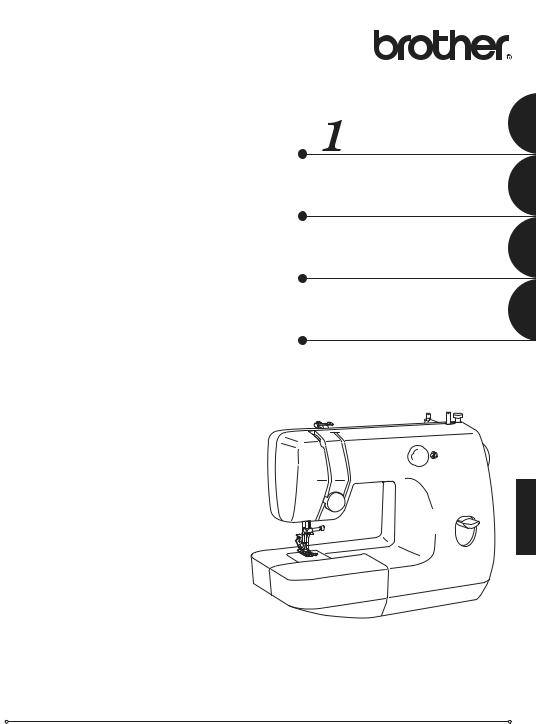
KNOWING YOUR
SEWING MACHINE
 SEWING BASICS
SEWING BASICS
 UTILITY STITCHES
UTILITY STITCHES
 APPENDIX
APPENDIX
ENGLISH
Basic Sewing and Mending Machine
Operation Manual
Please visit us at http://solutions.brother.com where you can get product support and answers to frequently asked questions (FAQs).

“IMPORTANT SAFETY INSTRUCTIONS”
When using the sewing machine, basic safety precautions should always be followed, including the following:
“Read all instructions before using.”
DANGER – To reduce the risk of electric shock:
1.The sewing machine should never be left unattended when plugged in. Always unplug this sewing machine from the electrical outlet immediately after using and before cleaning.
2.Always unplug before changing the light bulb. Replace bulb with same type rated 15 watts.
WARNING – To reduce the risk of burns, fire, electric shock, or injury to persons:
1.Do not allow this machine to be used as a toy. Close attention is necessary when the sewing machine is used by or near children.
2.Use this sewing machine only for its intended use as described in this manual. Use only accessories recommended by the manufacturer as contained in this manual.
3.Never operate this sewing machine if it has a damaged cord or plug, if it is not working properly, if it has been dropped or damaged, or dropped into water. Return the sewing machine to the nearest authorized dealer or service center for examination, repair, electrical or mechanical adjustment.
4.Never operate the sewing machine with any of the air openings blocked. Keep the ventilation openings of the sewing machine and foot controller free from the accumulation of lint, dust and loose cloth.
5.Never drop or insert any object into any openings.
6.Do not use this machine outdoors.
7.Do not operate this machine where aerosol (spray) products are being used or where oxygen is being administered.
8.To disconnect, turn the main switch to the symbol “O” position which represents off, then remove plug from outlet.
9.Do not unplug by pulling on the cord. To unplug, grasp the plug and pull, not the cord.
10.Keep fingers away from all moving parts. Special care is required around the sewing machine needle.
11.Always use the proper needle plate. The wrong plate can cause the needle to break.
12.Do not use a bent needle.
13.Do not pull or push the fabric while stitching. It may deflect the needle causing it to break.
14.Switch the sewing machine to the off, symbol “O” position when making any adjustments in the needle area, such as threading the needle, changing the needle, threading the bobbin, or changing the presser foot.
15.Always unplug the sewing machine from the electrical outlet when removing covers, lubricating, or when making any other user service adjustments mentioned in this instruction manual.
16.This sewing machine is not intended for use by young children or impaired persons without supervision.
17.Young children should be supervised to ensure that they do not play with this sewing machine.
“SAVE THESE INSTRUCTIONS”
“This sewing machine is intended for household use.”
1

CONGRATULATIONS ON CHOOSING OUR MACHINE
To fully enjoy all the features, we suggest that you study the manual before using the machine.
PLEASE READ BEFORE USING THIS MACHINE
For safe operation
1.Be sure to keep your eye on the needle while sewing. Do not touch the handwheel, thread takeup lever, needle, or other moving parts.
2.Remember to turn off the power switch and unplug the cord when:
•Operation is completed
•Replacing or removing the needle or any other parts
•A power failure occurs during use
•Maintaining the machine
•Leaving the machine unattended
3.Do not store anything on the foot controller.
4.Plug the machine directly into the wall. Do not use extension cords.
For a longer service life
1.When storing this machine, avoid direct sunlight and high humidity locations. Do not use or store the machine near a space heater, iron, halogen lamp, or other hot objects.
2.Use only neutral soaps or detergents to clean the case. Benzene, thinner, and scouring powders can damage the case and machine, and should never be used.
3.Do not drop or hit the machine.
4.Always consult the operation manual when replacing or installing any assemblies, the presser feet, needle, or other parts to assure correct installation.
For repair or adjustment
In the event a malfunction occurs or adjustment is required, first follow the troubleshooting table in the back of the operation manual to inspect and adjust the machine yourself. If the problem persists, please consult your local authorized Brother dealer.
For additional product information and updates, visit our web site at www.brother.com
The contents of this manual and specifications of this product are subject to change without notice.
FOR USERS IN THE UK, EIRE, MALTA AND CYPRUS ONLY
IMPORTANT
•In the event of replacing the plug fuse, use a fuse approved by ASTA to BS 1362, i.e. carrying the  mark, rating as marked on plug.
mark, rating as marked on plug.
•Always replace the fuse cover. Never use plugs with the fuse cover omitted.
•If the available electrical outlet is not suitable for the plug supplied with this equipment, you should contact your authorized dealer to obtain the correct lead.
FOR USERS IN AUSTRALIA AND NEW ZEALAND
This sewing machine is not intended to be used by young children, and assistance may be required if used by a person with a disability.
2

——————————————————————————————————————————————————————————
CONTENTS |
|
CONTENTS ......................................................................................................................... |
3 |
1. KNOWING YOUR SEWING MACHINE .......................................................... |
5 |
NAMES OF MACHINE PARTS AND THEIR FUNCTIONS .................................................... |
5 |
The main parts ................................................................................................................................................. |
5 |
Needle and presser foot section ...................................................................................................................... |
6 |
Flat bed attachment ......................................................................................................................................... |
6 |
ACCESSORIES ..................................................................................................................... |
7 |
OPTIONAL ACCESSORIES .................................................................................................. |
7 |
USING YOUR SEWING MACHINE ..................................................................................... |
8 |
Power supply precautions ................................................................................................................................ |
8 |
Power supply .................................................................................................................................................... |
8 |
Foot controller .................................................................................................................................................. |
9 |
Steadying the machine ..................................................................................................................................... |
9 |
THREADING THE MACHINE ............................................................................................ |
10 |
Winding the bobbin ........................................................................................................................................ |
10 |
Lower threading ............................................................................................................................................. |
11 |
Upper threading ............................................................................................................................................. |
13 |
Drawing up the lower thread .......................................................................................................................... |
14 |
REPLACING THE NEEDLE ................................................................................................. |
15 |
Needle precautions ........................................................................................................................................ |
15 |
Selecting the needle depending on the thread and fabric types .................................................................... |
15 |
Checking the needle ...................................................................................................................................... |
16 |
Replacing the needle ..................................................................................................................................... |
16 |
Sewing with a twin needle (Option) ................................................................................................................ |
18 |
REPLACING THE PRESSER FOOT ...................................................................................... |
19 |
Replacing the presser foot ............................................................................................................................. |
19 |
Removing the presser foot holder .................................................................................................................. |
20 |
2. SEWING BASICS ........................................................................................... |
21 |
SEWING ............................................................................................................................ |
21 |
General sewing procedure ............................................................................................................................. |
21 |
Selecting stitching .......................................................................................................................................... |
22 |
Starting to sew ............................................................................................................................................... |
23 |
Sewing in reverse ........................................................................................................................................... |
23 |
Thread tension ............................................................................................................................................... |
24 |
USEFUL SEWING TIPS ...................................................................................................... |
25 |
Trial sewing .................................................................................................................................................... |
25 |
Changing the sewing direction ....................................................................................................................... |
25 |
Sewing curves ................................................................................................................................................ |
25 |
Sewing thick fabrics ....................................................................................................................................... |
25 |
Sewing thin fabrics ......................................................................................................................................... |
26 |
Sewing stretch fabrics .................................................................................................................................... |
26 |
Using a free-arm style .................................................................................................................................... |
26 |
3. UTILITY STITCHES ........................................................................................ |
27 |
USEFUL STITCHES ............................................................................................................ |
27 |
Zigzag stitches ............................................................................................................................................... |
27 |
Basic stitching ................................................................................................................................................ |
28 |
Blind hem stitching ......................................................................................................................................... |
28 |
Darning ........................................................................................................................................................... |
30 |
3

BUTTONHOLE SEWING ................................................................................................... |
31 |
Making the buttonhole .................................................................................................................................... |
31 |
Adjusting buttonhole stitching ........................................................................................................................ |
32 |
Button sewing ................................................................................................................................................. |
33 |
ZIPPER INSERTION ........................................................................................................... |
34 |
APPLIQUÉ, MONOGRAMMING AND EMBROIDERING ................................................. |
35 |
Appliqués ....................................................................................................................................................... |
35 |
Monogramming and embroidering ................................................................................................................. |
35 |
DECORATIVE STITCHING ................................................................................................ |
37 |
Gathering ....................................................................................................................................................... |
37 |
Shell tuck stitching ......................................................................................................................................... |
37 |
Elastic stitching .............................................................................................................................................. |
38 |
4. APPENDIX ..................................................................................................... |
39 |
MAINTENANCE ................................................................................................................ |
39 |
Oiling .............................................................................................................................................................. |
39 |
Changing the bulb .......................................................................................................................................... |
39 |
Cleaning the machine surface ........................................................................................................................ |
40 |
Cleaning the shuttle race ............................................................................................................................... |
40 |
Cleaning the feed dogs .................................................................................................................................. |
41 |
Bobbin case tension adjustment .................................................................................................................... |
42 |
TROUBLESHOOTING ....................................................................................................... |
43 |
INDEX ............................................................................................................................... |
46 |
4
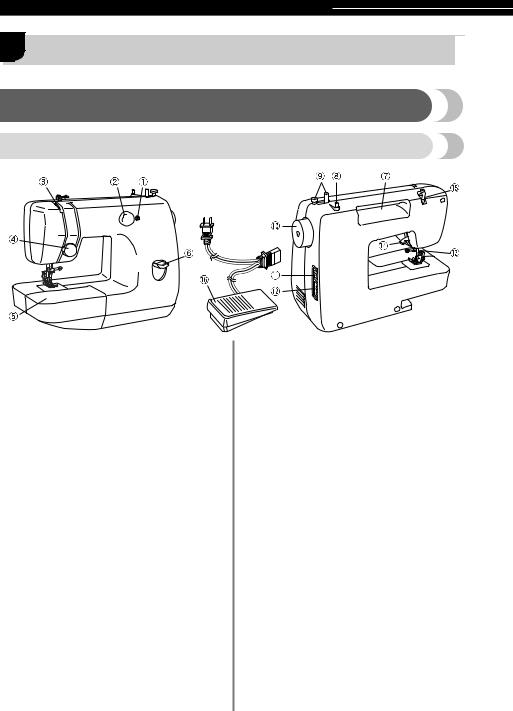
KNOWING YOUR SEWING MACHINE —————————————————————————————————————————
1 KNOWING YOUR SEWING MACHINE
NAMES OF MACHINE PARTS AND THEIR FUNCTIONS
The main parts
aButtonhole fine-adjusting screw (page 32)
Turn the buttonhole fine-adjusting screw to adjust buttonhole stitching when it is not uniform.
bPattern selection dial (page 22)
Turn the pattern selection dial to select the number of the stitch that you want to use.
cThread take-up lever (page 13)
dUpper tension control dial (page 24)
This controls the tension of the upper thread.
eFlat bed attachment with accessory storage (page 6 and 26)
fReverse sewing lever (page 23)
Press and hold down the reverse sewing lever to sew in the opposite direction.
gBuilt-in handle
hSpool pin (page 10 and 13)
The spool pin holds the spool of thread.
iBobbin winder (page 10)
The bobbin winder winds thread onto the bobbin for use as the lower thread.
jHandwheel
Use the handwheel to manually raise and lower the needle.
kMain power/sewing light switch (page 8)
Use this switch to turn on and off the main power and sewing light.
lFoot controller jack/jack
Insert the foot controller plug into the foot controller jack, which also supplies power to this machine.
mThread cutter (page 23)
Pass the threads through the thread cutter to cut them.
nPresser foot lever (page 13)
Use the presser foot lever to raise and lower the presser foot.
oBobbin winding pre-tension disc/thread guide (page 10 and 13)
The thread guide/bobbin winding pre-tension disc is used when winding the thread onto the bobbin and threading the machine.
pFoot controller (page 9)
Use the foot controller to control the sewing speed and to start and stop sewing.
Part code;
XC7359-021 (110/120V Area), XC7438-321 (220/240V Area), XC7456-321 (U.K.), XE0629-001 (Australia, New Zealand), XD0852-021 (Korea), XC7438-321 (Russia), XD0115-121(Argentina), XE3414-001(Brazil(120V)), XE4302-001(Brazil(220V)),XE3447-001(Taiwan)
5
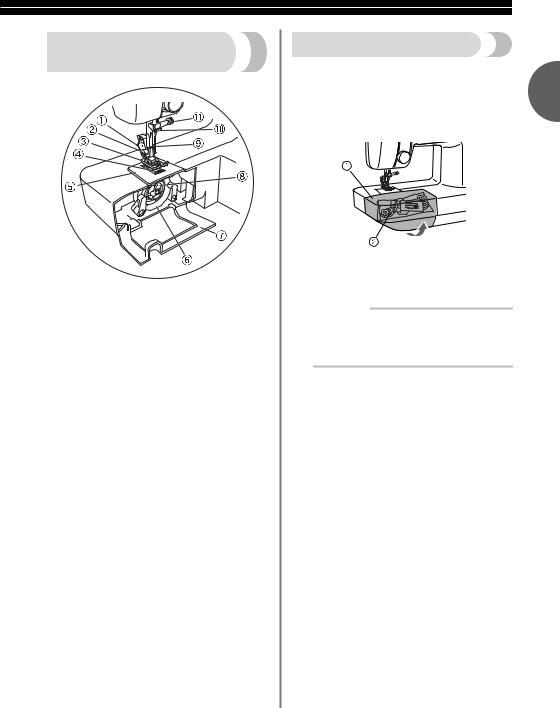
Needle and presser foot section
aPresser foot holder assembly
The presser foot is installed onto the presser foot holder assembly.
bPresser foot screw
Use the presser foot screw to hold the presser foot holder assembly in place.
cPresser foot (Zigzag)
The presser foot applies pressure consistently on the fabric as the sewing takes place. Attach the appropriate presser foot for the selected stitching.
dFeed dogs
The feed dogs feed the fabric in the sewing direction.
eNeedle plate
The needle plate is marked with guides for sewing straight seams.
fShuttle hook
gShuttle cover
Open the shuttle cover to set the bobbin.
hBobbin case
iNeedle
jNeedle bar thread guide
kNeedle clamp screw
Use the needle clamp screw to hold the needle in place.
Flat bed attachment
The accessories are stored in a compartment inside the flat bed attachment.
aLift the bottom of the flat bed attachment 1 toward you, and then pull the flat bed
attachment out to remove it.
aFlat bed attachment
bStorage compartment
 Note
Note
●Put the accessories in the bag, and then store the bag inside the compartment. If the accessories are not in a bag, they may fall out, and be lost or damaged.
6
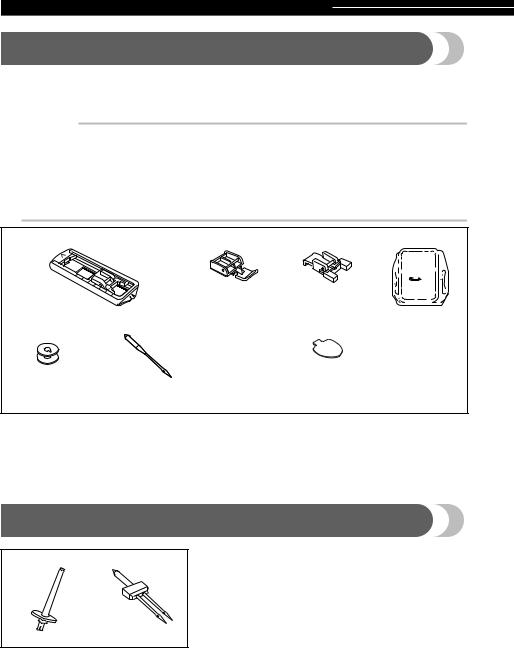
KNOWING YOUR SEWING MACHINE —————————————————————————————————————————
ACCESSORIES
The following accessories are stored in the flat bed attachment. We have designed these accessories to help you be able to carry out most sewing tasks.
 Note
Note
(For U.S.A. only)
●Foot controller: Model KD-1902, N
This foot controller can be used on the following machine models: VX-1435/LX-3125.
●The screw of the presser foot holder is available through your authorized dealer. (Part code: 132730-122)
●A replacement for the factory-installed presser foot is available through your authorized dealer. (Part number: 138135-122)
1. |
2. |
3. |
4. |
5. |
6. |
7. |
90/14 needle
No. |
Part Name |
Part Code |
|
No. |
Part Name |
Part Code |
||
|
|
U.S.A. / Canada |
|
Others |
|
|
U.S.A. / Canada |
Others |
1 |
Buttonhole foot “A” |
X59369 |
-321 |
5 |
Bobbin |
SA156 |
XA5539-151 |
|
2 |
Zipper foot “I” |
X59370-021 |
6 |
Needle set |
XE5328 |
-001 |
||
3 |
Button sewing foot “M” |
XE2137-001 |
7 |
Oval screwdriver |
XE5241-001 |
|||
4 |
Darning plate |
XA3442-121 |
|
|
|
|
||
OPTIONAL ACCESSORIES
1.2.
No. |
Part Name |
Part Code |
|
|
|
|
U.S.A. / Canada |
|
Others |
1 |
Extra spool pin |
130920 |
-021 |
|
2 |
Twin needle |
X57521-021 |
||
7
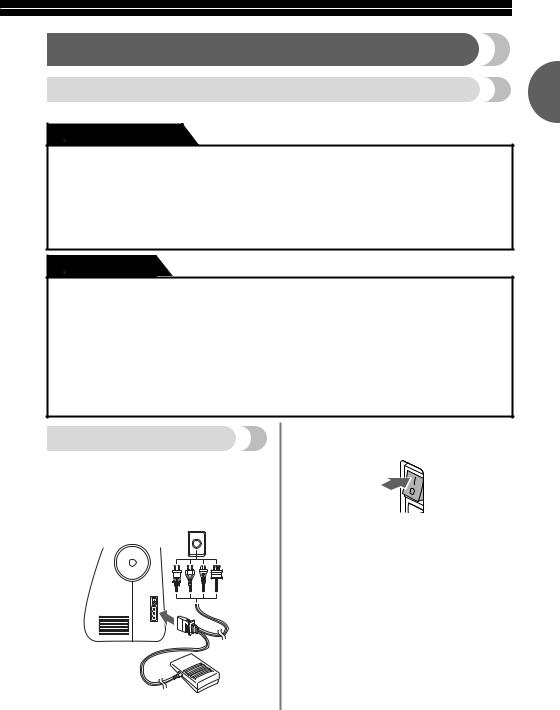
USING YOUR SEWING MACHINE
Power supply precautions |
1 |
|
Be sure to observe the following precautions concerning the power supply.

 WARNING
WARNING
●Use only regular household electricity for the power source. Using other power sources may result in fire, electric shock, or damage to the machine.
●Turn off the main power and remove the plug in the following circumstances:
•When you are away from the machine
•After using the machine
•When the power fails during use
•When the machine does not operate correctly due to a bad connection or a disconnection
•During electrical storms

 CAUTION
CAUTION
●Do not use extension cords or multi-plug adapters with many other appliances plugged in to them. Fire or electric shock may result.
●Do not touch the plug with wet hands. Electric shock may result.
●When unplugging the machine, always turn off the main power first. Always grasp the plug to remove it from the outlet. Pulling on the cord may damage the cord, or lead to fire or electric shock.
●Do not allow the power cord to be cut, damaged, modified, forcefully bent, pulled, twisted, or bundled. Do not place heavy objects on the cord. Do not subject the cord to heat. These things may damage the cord and cause fire or electric shock. If the cord or plug is damaged, take the machine to your authorized dealer for repairs before continuing use.
●Unplug the power cord if the machine is not to be used for a long period of time. Otherwise a fire may result.
Power supply
aInsert the foot controller plug, located between the foot controller and the power supply plug on the cord, into the jack on the machine. Then, insert the power supply plug into a wall outlet.
bSet the main power switch to “I”.
XThe sewing lamp comes on when the machine is turned on.
a Foot controller plug
8
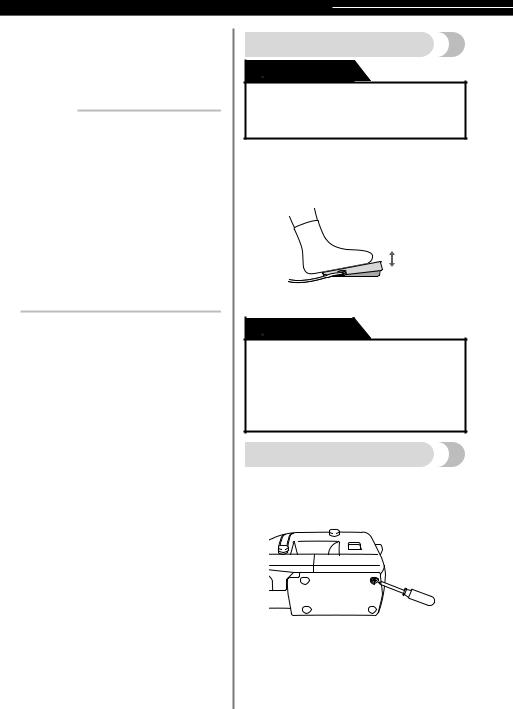
KNOWING YOUR SEWING MACHINE —————————————————————————————————————————
cTo turn off the machine, set the main power switch to “{”.
XThe sewing lamp goes off when the machine is turned off.
 Note
Note
●If a power outage occurs while the sewing machine is being operated, turn off the sewing machine and unplug the power supply cord. When restarting the sewing
machine, follow the necessary procedure to correctly operate the machine.
(For U.S.A. only)
●This appliance has a polarized plug (one blade wider than the other). To reduce the risk of electric shock, this plug is intended to fit in a polarized outlet only one way. If the plug does not fit fully in the outlet, reverse the plug.
If it still does not fit, contact a qualified electrician to install the proper outlet. Do not modify the plug in any way.
Foot controller

 CAUTION
CAUTION
●When connecting the foot controller, be sure to turn off the sewing machine in order to prevent the machine from accidentally being started.
When you press the foot controller down lightly, the machine will run at a low speed. When you press harder, the machine’s speed will increase. When you take your foot off the foot controller, the machine will stop.
Slower
Faster
You should make sure that nothing is placed on the foot controller when the machine is not in use.

 CAUTION
CAUTION
●Do not allow pieces of cloth and dust to build up on the foot controller. Doing so could cause a fire or an electric shock.
●A new sewing machine or one that has not been in use for a long period of time should be oiled as described on page 39. After oiling, be sure to wipe off any excess oil.
Steadying the machine
If the sewing machine has been placed on an uneven surface, turn the rubber cushion in the right-front corner of the base plate to adjust its height until the sewing machine is stable.
9

THREADING THE MACHINE
Winding the bobbin |
1 |
|
This section describes how to wind the thread onto the bobbin.
1 Pulling it in as far as possible.
aPre-tension disk
bBobbin winder shaft
cBobbin

 CAUTION
CAUTION
●Only use bobbins (part code: SA156, SFB: XA5539-151) that have been designed for this sewing machine. Using other bobbins may cause damage to the machine.
●We designed the bobbin that comes with this machine. If you use bobbins from other models, the machine will not work properly. Only use the bobbin that comes with this machine or bobbins of the same type (part code: SA156, SFB: XA5539-151).
Actual size
11.5 mm (7/16 inches)
This model |
Other models |
aPull up the spool pin as far as possible, and then put a spool of thread on this pin.
bPass the thread around the pre-tension disk.

 CAUTION
CAUTION
●If the spool of thread is not in the right place, the thread may tangle on the spool pin.
cPass the end of the thread through the hole on the bobbin from the inside of the bobbin.
dPut the bobbin onto the bobbin winder shaft and slide the bobbin winder shaft to the right. Turn the bobbin clockwise, by hand, until the spring on the shaft slides into the groove of the bobbin.
eTurn on the sewing machine.
fWhile holding the end of the thread, gently press the foot controller to wind the thread around the bobbin a few times. Then stop the machine.
aSpring on the shaft
bGroove of the bobbin
10
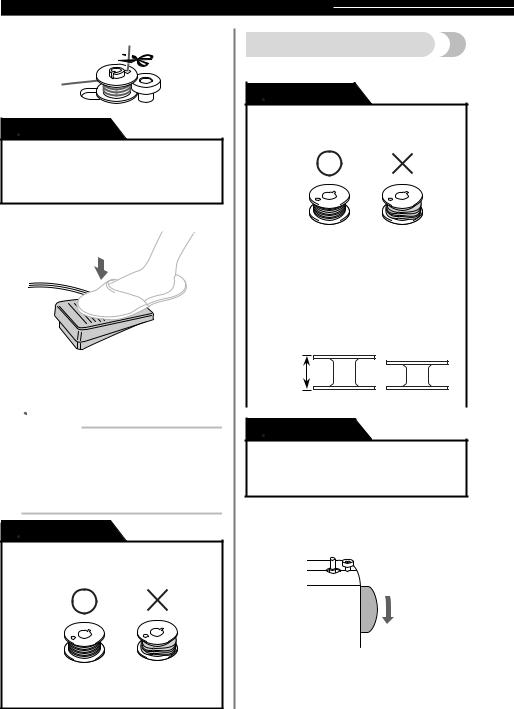
KNOWING YOUR SEWING MACHINE —————————————————————————————————————————
gTrim the excess thread above the bobbin.

 CAUTION
CAUTION
●Make sure you follow the instructions carefully. If you do not cut the thread completely, and the bobbin is wound, when the thread runs low it may tangle around the bobbin and cause the needle to break.
hPress the foot controller to start.
iWhen the bobbin seems full and begins spinning slowly, take your foot off the foot controller.
jCut the thread, slide the bobbin winder shaft to the left and remove the bobbin.
 Memo
Memo
●When the sewing machine is started or the handwheel is turned after winding the thread around the bobbin, the machine will make a clicking sound; this is not a malfunction.
●The needle bar does not move when you slide the bobbin winding shaft to the right.

 CAUTION
CAUTION
●Winding the bobbin improperly may cause the thread tension to loosen, breaking the needle and resulting in injury.
Lower threading
Install the bobbin wound with thread.

 CAUTION
CAUTION
●Winding the bobbin improperly may cause the thread tension to loosen, breaking the needle and resulting in injury.
12
aWound evenly
bWound poorly
●The bobbin was designed specifically for this sewing machine. If bobbins from other models are used, the machine will not operate correctly. Use only the enclosed bobbin or bobbins of the same type (part code: SA156, SFB: XA5539-151).
Actual size
11.5 mm (7/16 inches)
This model |
Other models |
|
|

 CAUTION
CAUTION
●Make sure you turn the power off while threading the machine. If you accidentally step on the foot controller and the machine starts to sew, you could be injured.
aRaise the needle to its highest position by turning the handwheel toward you (counterclockwise) and raise the presser foot lever.
12
aWound evenly
bWound poorly
11
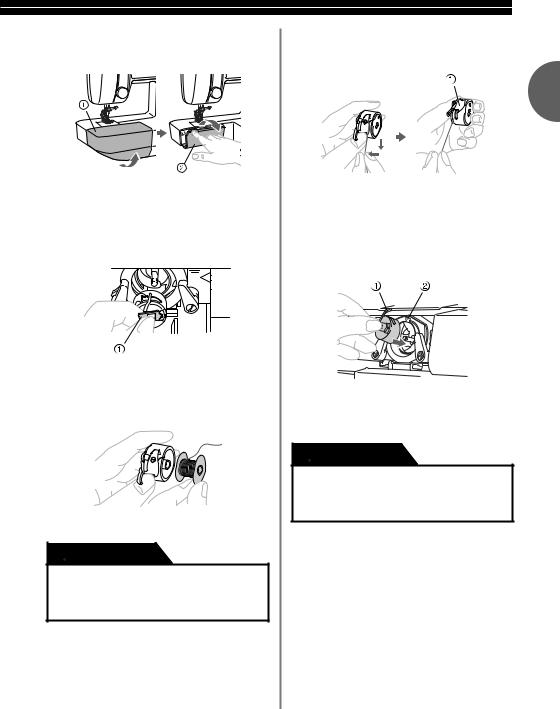
bOpen the shuttle cover behind the flat bed attachment at the front of the machine.
aFlat bed attachment
bShuttle cover
cRemove the bobbin case by pulling its latch toward you and pulling it out from the shuttle race.
a Bobbin case latch
dUnwind about 10 cm (4 inches) of thread from a full bobbin, and then insert the bobbin into the bobbin case.
•Only use bobbins that were designed to be used with this machine.

 CAUTION
CAUTION
●Make sure you set the bobbin so the thread unrolls in the right direction. If the thread unrolls in the wrong direction, it may cause the thread tension to be incorrect or break the needle.
ePull the trailing thread through the slot, down and to the left, as shown below, until it enters the delivery eye under the tension spring.
1
a Tension spring
fHold the bobbin case by the latch, fully insert the bobbin case into the shuttle race, and then release the latch.
•Make sure the bobbin case finger fits into the notch at the top of the shuttle race.
aBobbin case finger
bNotch
gClose the shuttle cover.

 CAUTION
CAUTION
●Make sure that the bobbin case is properly placed back into the machine. If it is incorrectly installed, it will fall out from the shuttle when the machine starts to sew.
12
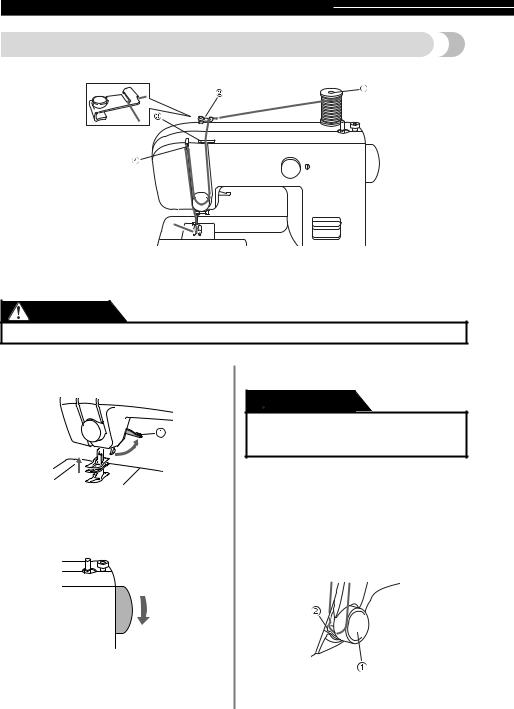
KNOWING YOUR SEWING MACHINE —————————————————————————————————————————
Upper threading
Set the upper thread and thread the needle.
aSpool pin
bThread guide (rear)
cThread guide (front)
dThread take-up lever
CAUTION
● Make sure you thread the machine properly. Otherwise, the thread could tangle and break the needle.
aRaiselever.the presser foot using the presser foot
a Presser foot lever
bRaise the needle by turning the handwheel toward you (counterclockwise) to raise the thread take-up lever to its highest position.
cPull up the spool pin as far as possible, and then put a spool of thread on this pin.

 CAUTION
CAUTION
●If the spool of thread is in the wrong place, or is set incorrectly, the thread may tangle on the spool pin and cause the needle to break.
dFeed the upper thread through both thread guides: the rear one first, then the front one.
ePull the thread down and around the upper tension control dial from the right to the left so the thread picks up the thread check spring.
•If the needle is not correctly raised, the sewing machine can not be threaded. Be sure to turn the handwheel before threading the sewing machine.
aUpper tension control dial
bThread check spring
13
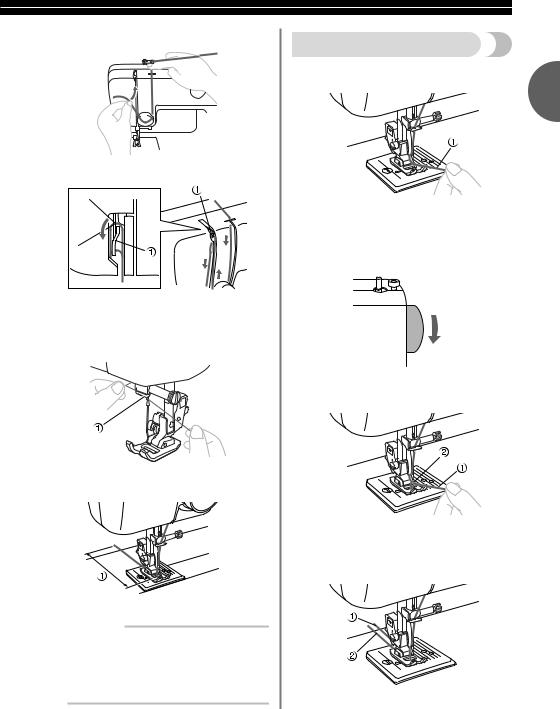
fWhile holding the thread as shown below, pull it between the tension discs.
gGuide the thread through the thread take-up lever from right to left.
a Thread take-up lever
hPut the thread behind the needle bar thread guide above the needle.
The thread can easily be passed behind the needle bar thread guide by holding the thread in your left hand, then feeding the thread with your right hand.
a Needle bar thread guide
iThread the needle from front to back and pull out about 5 cm (2 inches) of thread.
a 5 cm (2 inches)
 Note
Note
●If the thread take-up lever is lowered, the upper thread cannot be wrapped around the thread take-up lever. Make sure you raise the presser foot lever and the thread take-up lever before you feed the upper thread.
●If you incorrectly feed the thread you may cause sewing problems.
Drawing up the lower thread
aLightly hold the end of the upper thread.
1
a Upper thread
bWhile holding the end of the upper thread, raise the needle to its highest position by turning the handwheel toward you (counterclockwise).
cPullthread.on the upper thread to draw up the lower
aUpper thread
bLower thread
dPull out about 15 cm (6 inches) of both threads and pull them toward the back of the machine under the presser foot.
aUpper thread
bLower thread
14
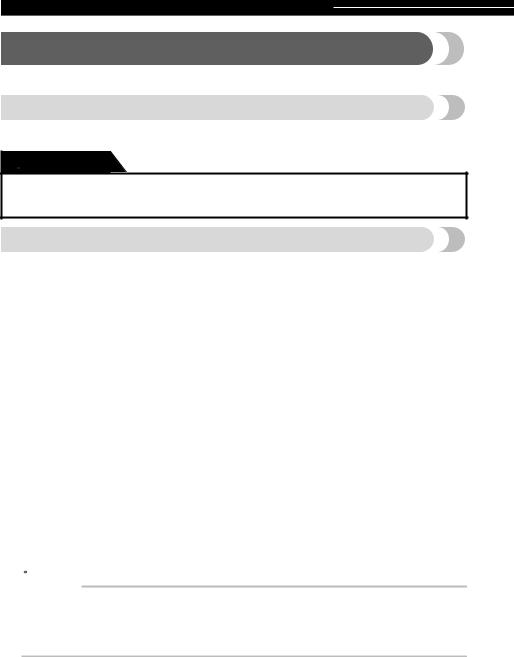
KNOWING YOUR SEWING MACHINE —————————————————————————————————————————
REPLACING THE NEEDLE
This section provides information on sewing machine needles.
Needle precautions
Be sure to observe the following precautions concerning the handling of the needle. Failure to observe these precautions is extremely dangerous. Be sure to read and carefully follow the instructions below.

 CAUTION
CAUTION
●Only use home sewing machine needles. Use of any other needle may bend the needle or damage the machine.
●Never use bent needles. Bent needles can easily break, possibly resulting in injury.
Selecting the needle depending on the thread and fabric types
The sewing machine needle that should be used depends on the fabric and thread thickness. Refer to the following table when choosing the thread and needle appropriate for the fabric that you wish to sew. Use the same size thread for the upper (spool) and lower (bobbin) threads.
|
Sewing fabrics |
Needle sizes |
Thread sizes |
|
|
||||
|
|
Fine tricot, Fine lace, |
|
Cotton: 80 |
|
|
|
Synthetic/ Polyester Long |
|
Very thin |
|
Thin linen, Silk, |
65/9 |
|
|
Fiber |
|||
|
|
Organza, Chiffon |
|
|
|
|
|
Fine Mercerized Cotton |
|
|
|
|
|
|
|
|
|
|
Cotton: 60-80 |
Lightweight |
|
Voile, Taffeta, |
|
Silk: “A” |
|
75/11 |
Synthetic/ Polyester Long |
||
|
Synthetics, Silk, Batiste |
|||
|
|
|
|
Fiber |
|
|
|
|
Mercerized 50 |
|
|
Cotton, Gingham, |
|
Cotton: 50-60 |
|
|
Poplin, Percale, Pique, |
|
|
|
|
|
Silk: “A” |
|
Medium weight |
|
Satin, Velvet, |
90/14 (Supplied with |
|
|
Lightweight wool, |
your machine.) |
Synthetic/ Polyester Long |
|
|
|
Fiber |
||
|
|
Fine corduroy, Suitings, |
|
|
|
|
|
Mercerized 50-60 |
|
|
|
Linen, Muslin |
|
|
|
|
|
|
|
|
|
Denim, Gabardine, |
|
Cotton: 40-50 |
Heavyweight |
|
Tweed, Corduroy, |
100/16 |
Mercerized Heavy Duty |
|
|
Canvas, Duck |
|
Polyester Long Fiber |
Knits |
|
Single knit, Double knit, |
|
Cotton Wrapped |
|
90/14 (Ball point) |
Polyester |
||
|
|
Jersey, Tricot |
|
Polyester Long Fiber |
|
|
|
|
|
|
|
|
|
|
 Memo
Memo
●The smaller the thread number, the thicker the thread; and the larger the needle number, the thicker the needle.
●Use the ball point needle when sewing on stretch fabrics or fabrics where skipped stitches easily occur.
●Use a 90/14 to 100/16 needle with transparent nylon threads, regardless of the fabric being sewn.
●A 75/11 needle is already installed when the sewing machine is purchased.
15
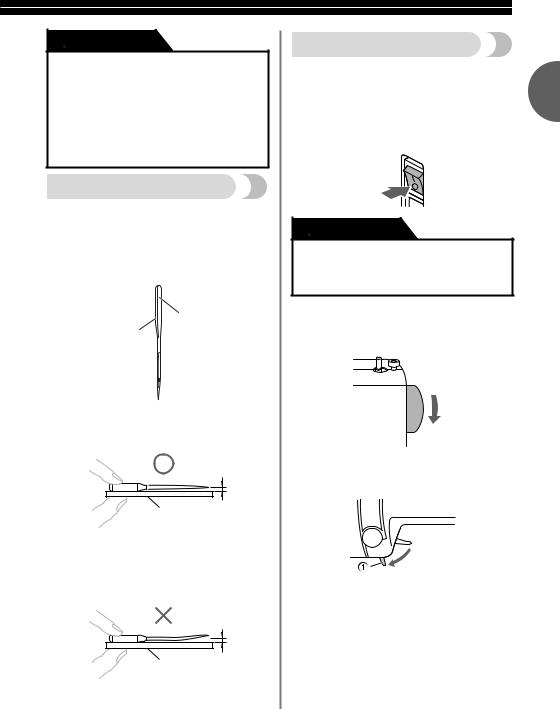

 CAUTION
CAUTION
●The appropriate fabric, thread and needle combinations are shown in the table on the previous page. If the combination of the fabric, thread and needle is not correct, particularly when sewing thick fabrics (such as denim) with thin needles (such as 65/9 to 75/11), the needle may bend or break. In addition, the stitching may be uneven or puckered or there may be skipped stitches.
Checking the needle
Sewing with a bent needle is extremely dangerous since the needle may break while the machine is being operated.
Before using the needle, place the flat side of the needle on a flat surface and check that the distance between the needle and the flat surface is even.
1
2
aFlat side
bNeedle type marking
■Correct needle
1
aFlat surface
■Incorrect needle
If the distance between the needle and the flat surface is not even, the needle is bent. Do not use a bent needle.
1
a Flat surface
Replacing the needle
Replace the needle as described below. Use the oval screwdriver and a needle that has been determined
to be straight according to the instructions in 1 “Checking the needle” .
aTurn off the sewing machine.

 CAUTION
CAUTION
●Before replacing the needle, be sure to turn off the sewing machine, otherwise injuries may occur if the foot controller is accidentally pressed and the machine starts sewing.
bRaise the needle to its highest position by turning the handwheel toward you (counterclockwise).
cLower the presser foot lever.
a Presser foot lever
16
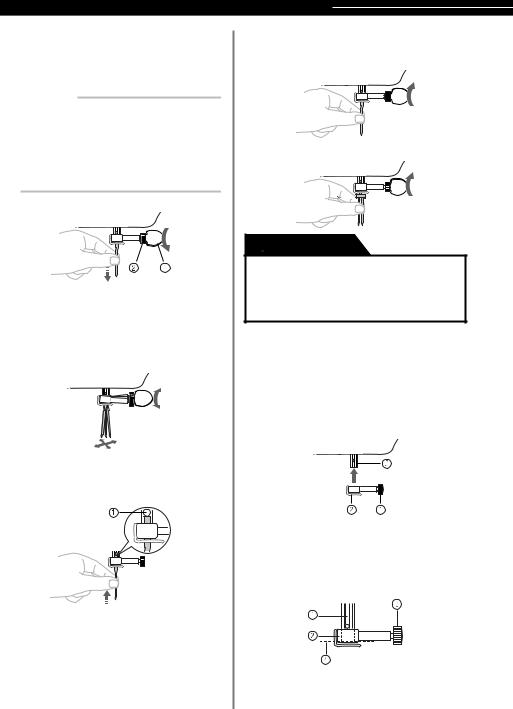
KNOWING YOUR SEWING MACHINE —————————————————————————————————————————
dHold the needle with your left hand, and then use a oval screwdriver to turn the needle clamp screw counterclockwise to remove the needle.
 Note
Note
●The needle can be removed by simply loosening the needle clamp screw about one turn. (If the needle clamp screw is loosened too much, the needle clamp (which holds the needle) may fall off. Therefore, do not loosen the needle clamp screw too much.)
aOval screwdriver
bNeedle clamp screw
•Do not apply strong force when loosening or tightening the needle clamp screw, otherwise certain parts of the sewing machine may be damaged.
eWith the flat side of the needle toward the rear of the machine, insert the needle until it touches the needle stopper.
a Needle stopper
fWhile holding the needle with your left hand, use the oval screwdriver to tighten the needle clamp screw by turning it clockwise.
Install the twin needle in the same way.

 CAUTION
CAUTION
●Be sure to insert the needle until it touches the needle stopper and securely tighten the needle clamp screw with the oval screwdriver, otherwise the needle may break or damage may result.
■Installing the needle clamp
If the needle clamp is removed, follow the procedure below to attach it to the needle bar.
aAs seen from the front of the machine, slide the needle clamp onto the needle bar so that the needle clamp screw is on the right side and the needle bar thread guide is at the bottom.
aNeedle clamp screw
bNeedle bar thread guide
cNeedle bar
bAlign the bottom edge of the needle holder with the end of the needle bar, and then tighten the needle clamp screw.
aNeedle bar
bNeedle holder
cNeedle clamp screw
dAlign
17
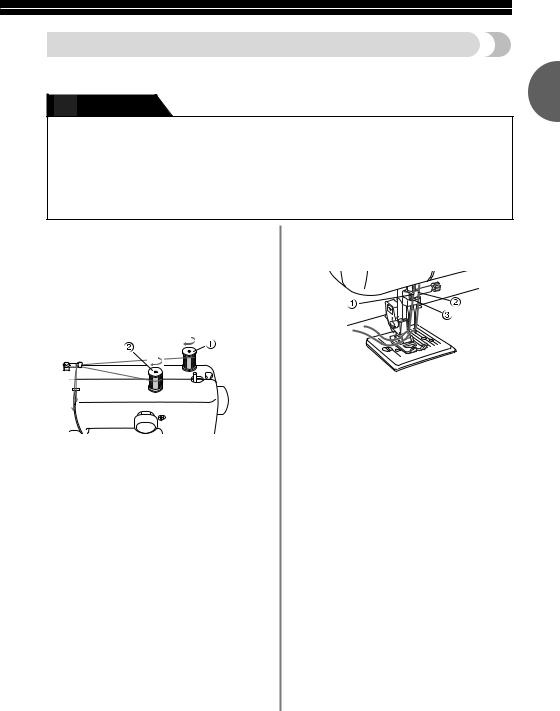
Sewing with a twin needle (Option)
We have designed your machine so you can sew with the optional twin needle and two top threads. You can use the same color or two different colors of thread for making decorative stitches.
The stitches available for twin-needle sewing are straight stitches 6 through 10 and zigzag stitch 2. 1
CAUTION
●Use only twin needles that have been made for this machine (part code: X57521-021). Other needles could break, and damage the machine.
●Do not sew with bent needles. The needle could break and injure you.
●When using the twin needle, be sure to select an appropriate stitch (straight stitches 6 through 10 and zigzag stitch 2), otherwise the needle may break or the machine may be damaged.
●Slowly turn the handwheel toward you (counterclockwise) and check that the needle does not touch the presser foot. If the needle hits the presser foot, the needle may bend or break.
●When changing the sewing direction, be sure to raise the needle before turning the fabric. If the fabric is turned while the needle is lowered, the needle may bend or break.
■ Twin needle threading
aAttach the twin needle.
Attach the twin needle in the same way as a single needle (page 16).
bAttach the extra spool pin.
Put the extra spool pin in the hole on the top of the machine. Put the second spool of thread onto the extra spool pin.
aFirst spool
bSecond spool
cUse the thread from the first spool to thread the machine to the needle bar thread guide.
The path for threading the machine to the needle bar thread guide is the same as for normally threading the machine (for a single needle). See page 13 for more details.
dThread the left needle from front to back.
eUse the thread from the second spool to thread the machine to the thread take-up lever.
The path for threading the machine to the thread take-up lever is the same as for normally threading the machine (for a single needle). See page 13 for more details.
fThread the right needle from front to back.
Do not pass the thread behind the needle bar thread guide.
aLeft needle thread passes through the needle bar thread guide.
bRight needle thread passes in front of the needle bar thread guide.
cNeedle bar thread guide
18
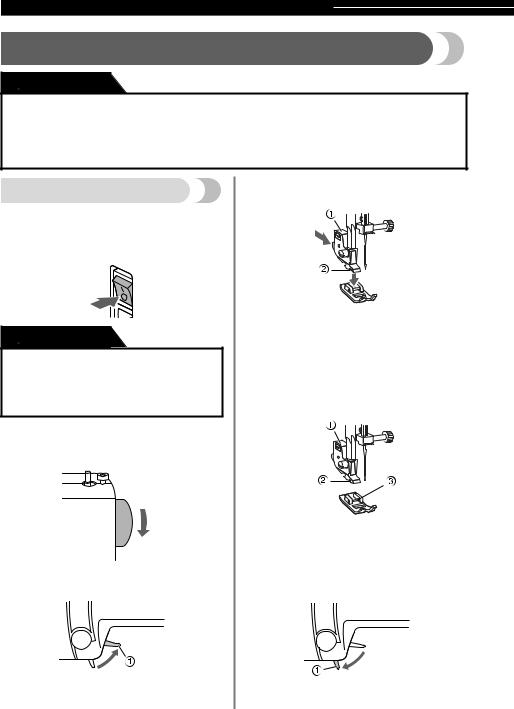
KNOWING YOUR SEWING MACHINE —————————————————————————————————————————
REPLACING THE PRESSER FOOT

 CAUTION
CAUTION
●Always turn off the power before you change the presser foot. If you leave the power on and step on the controller, the machine will start and you may be injured.
●Always use the correct presser foot for the stitch pattern you have chosen. If you use the wrong presser foot, the needle may strike the presser foot and bend or break, and may cause injury.
●Only use presser feet that have been designed to be used with this machine. Using other any presser feet may cause an accident or injury.
Replacing the presser foot
Replace the presser foot as described below.
aIfturntheitsewingoff. machine has been turned on,

 CAUTION
CAUTION
●Before replacing the presser foot, be sure to turn off the sewing machine, otherwise injuries may occur if the foot controller is accidentally pressed and the machine starts sewing.
bRaise the needle to its highest position by turning the handwheel toward you (counterclockwise).
cRaise the presser foot lever.
dPress the black button at the back of the presser foot holder to release the presser foot.
aBlack button
bPresser foot holder
ePlace a different presser foot below the holder so that the presser foot pin is aligned with the shank in the holder.
Position the presser foot so the letter indicating the presser foot type (A, I, etc.) is positioned to be read.
aPresser foot holder
bShank
cPin
fSlowly lower the presser foot lever so that the presser foot pin snaps into the shank in the presser foot holder.
a Presser foot lever |
a Presser foot lever |
|
X The presser foot is attached. |
19
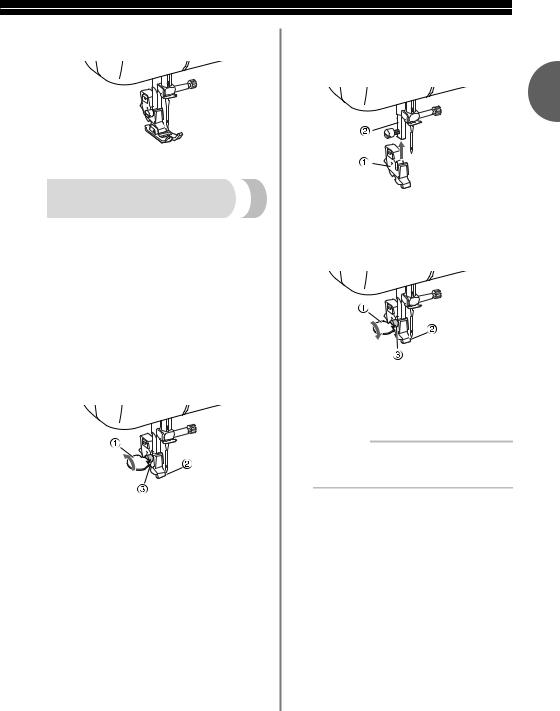
gRaise the presser foot lever to check that the presser foot is securely attached.
Removing the presser foot holder
Remove the presser foot holder when cleaning the sewing machine or when installing a presser foot that does not use the presser foot holder, such as the quilting foot. Use the oval screwdriver to remove the presser foot holder.
■ Removing the presser foot holder
aRemove the presser foot.
•For details, refer to “Replacing the presser foot” (page 19).
bUse the oval screwdriver to loosen the presser foot holder screw.
aOval screwdriver
bPresser foot holder
cPresser foot holder screw
■ Attaching the presser foot holder
aAlign the presser foot holder with the lowerleft side of the presser bar.
1
aPresser foot holder
bPresser bar
bHold the presser foot holder in place with your right hand, and then tighten the screw using the oval screwdriver in your left hand.
aOval screwdriver
bPresser foot holder
cPresser foot holder screw
 Note
Note
●If the presser foot holder is not correctly installed, the thread tension will be incorrect.
20
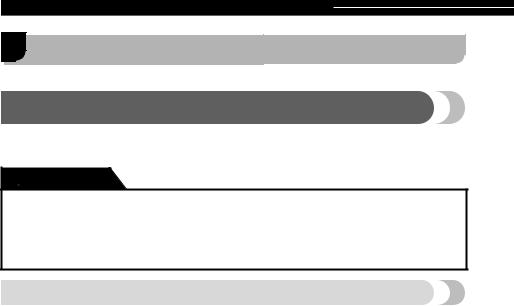
SEWING BASICS ———————————————————————————————————————————————————
2 SEWING BASICS
SEWING
Basic sewing operations are described below.
Before operating the sewing machine, read the following precautions.

 CAUTION
CAUTION
●While the machine is in operation, pay special attention to the needle location. In addition, keep your hands away from all moving parts such as the needle and handwheel, otherwise injuries may occur.
●Do not pull or push the fabric too hard while sewing, otherwise injuries may occur or the needle may break.
●Never use bent needles. Bent needles can easily break, possibly resulting in injuries.
●Make sure that the needle does not strike basting pins, otherwise the needle may break or bend.
General sewing procedure
Follow the basic procedures below to sew.
1 |
Turn on the |
Turn on the sewing machine. |
|
machine. |
For details on turning on the machine, refer to “Power supply” (page 8). |
||
|
|||
|
|
|
|
|
|
↓ |
|
|
|
|
|
2 |
Select the stitch. |
Select the stitch appropriate for the area to be sewn. |
|
For details on selecting a stitch, refer to “Selecting stitching” (page 22). |
|||
|
|
||
|
|
|
|
|
|
↓ |
|
|
|
|
|
3 |
Attach the presser |
Attach the presser foot appropriate for the stitch. |
|
For details on replacing the presser foot, refer to “Replacing the presser |
|||
foot. |
|||
|
foot” (page 19). |
||
|
|
||
|
|
|
|
|
|
↓ |
|
|
|
|
|
4 |
Start sewing. |
Position the fabric, and then start sewing. When sewing is finished, cut the |
|
threads. |
|||
|
|
For details on starting to sew, refer to “Starting to sew” (page 23). |
|
|
|
|
21
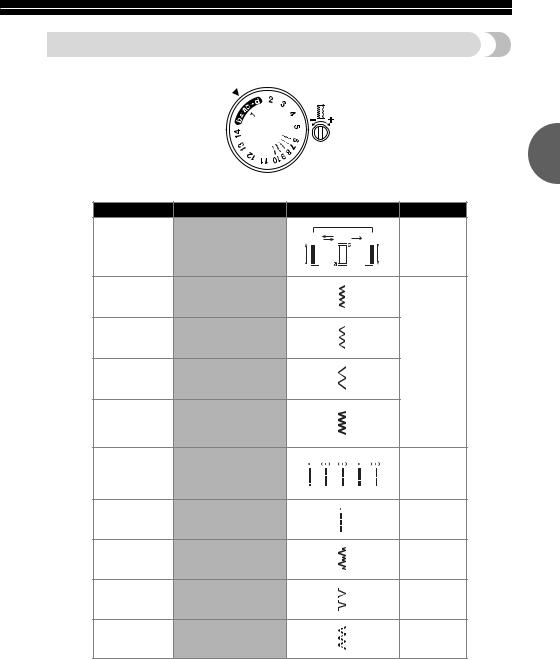
Selecting stitching
Turning the stitch selection dial in either direction, select the desired stitch.
2
Pattern selection dial
Number on dial |
Stitch name |
|
Pattern |
Page |
||
|
4-step automatic |
b |
|
ac |
|
d |
1 |
|
|
|
|
31 |
|
buttonhole |
|
|
|
|
||
|
|
|
|
|
|
|
2 |
Zigzag stitch |
|
|
|
|
|
3 |
Zigzag stitch |
|
|
|
|
|
|
|
|
|
|
|
27, 35 |
4 |
Zigzag stitch |
|
|
|
|
|
5 |
Zigzag (satin) stitch |
|
|
|
|
|
|
Straight stitch |
6 |
7 |
8 |
9 |
10 |
6 -10 |
|
|
|
|
28, 30, |
|
(Center needle position) |
|
|
|
|
34, 37 |
|
|
|
|
|
|
||
|
|
Select the desired length. |
||||
11 |
Straight stitch |
|
|
|
|
28 |
(Left needle position) |
|
|
|
|
||
|
|
|
|
|
|
|
12 |
Stretch blind |
|
|
|
|
28 |
Stitch |
|
|
|
|
||
|
|
|
|
|
|
|
13 |
Shell tuck stitch |
|
|
|
|
37 |
14 |
Elastic stitch |
|
|
|
|
38 |
22
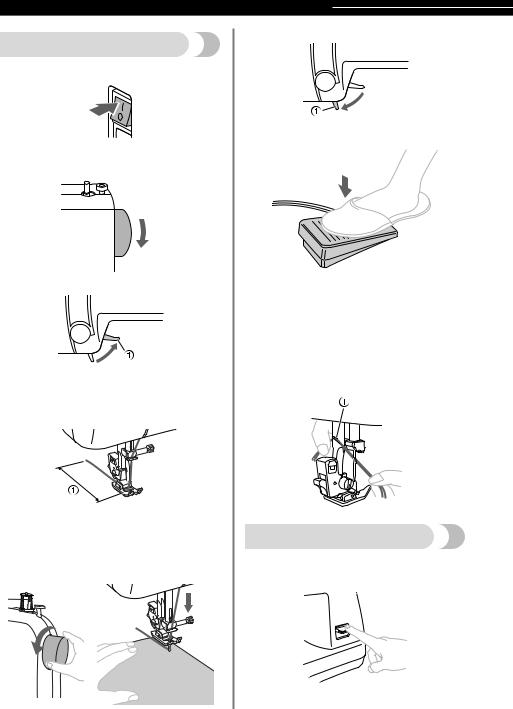
SEWING BASICS ———————————————————————————————————————————————————
Starting to sew
aTurn on the sewing machine.
bRaise the needle to its highest position by turning the handwheel toward you (counterclockwise).
cRaise the presser foot lever.
a Presser foot lever
dPlace the fabric under the presser foot, pass the thread under the presser foot, and then pull out about 5 cm (2 inches) of thread toward the rear of the machine.
a 5 cm (2 inches)
eWhile holding the end of the thread and the fabric with your left hand, turn the handwheel toward you (counterclockwise) with your right hand to lower the needle to the starting point of the stitching.
fLower the presser foot lever.
a Presser foot lever
gSlowly press down on the foot controller.
XThe machine starts sewing.
hTake your foot off the foot controller.
XThe machine stops sewing.
iRaise the needle to its highest position by turning the handwheel toward you (counterclockwise).
jRaise the presser foot lever.
kPull the fabric to the left side of the machine, and then pass the threads through the thread cutter on the back of the presser foot bar to cut them.
a Thread cutter
Sewing in reverse
Reverse sewing is used to lock the threads at the end of the seam or wherever reinforcement is needed.
aPress and hold down the reverse sewing lever while sewing.
bTo sew forward, release the reverse sewing lever.
23
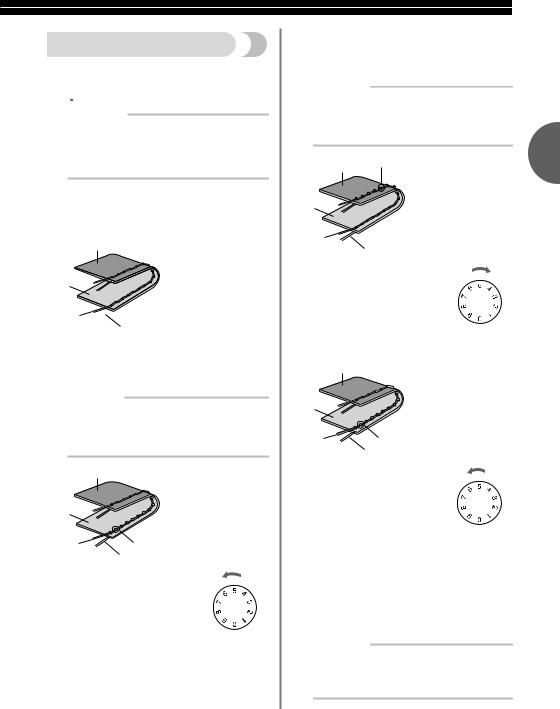
Thread tension
The thread tension will affect the quality of your stitches. You may need to adjust it when you change fabric or thread.
 Memo
Memo
●Before beginning to change tension adjustments make sure the upper thread and bobbin are inserted correctly.
●We recommend you do a test sample on a scrap of fabric before you start to sew.
■Correct tension
Correct tension is important as too much or too little tension will weaken your seams or cause puckers on your fabric.
|
1 |
|
a Wrong side |
2 |
b Surface |
|
c Upper thread |
d Lower thread
3 

4
■Upper tension is too tight
Loops appear on the surface of the fabric.
 Note
Note
●If the bobbin thread was incorrectly inserted, the upper thread may be too tight. In this case, refer to “Lower threading” (page 11) and reinsert the bobbin.
|
1 |
|
|
|
a Wrong side |
|
|
b Surface |
2 |
|
c Upper thread |
|
|
d Lower thread |
|
|
e Loops appear on |
3 |
5 |
surface of fabric |
|
4
Solution
Reduce the tension by turning the upper tensioncontrol dial to a lower number.
■Upper tension is too loose
Loops appear on the wrong side of the fabric.
 Note
Note
●If the upper thread was incorrectly threaded, the upper thread may be too loose. In this case, refer to “Upper threading” (page 13) and rethread.
1 |
5 |
2 |
|
|
|
|
|
a Wrong side |
|
|
b Surface |
2 |
|
c Upper thread |
|
d Lower thread |
|
|
|
|
|
|
e Loops appear on |
3 |
|
wrong side of |
|
fabric |
|
|
|
4
Solution
Increase the tension by turning the upper tensioncontrol dial to a higher number.
■Bobbin tension is too loose
Loops may appear on the surface of the fabric when sewing thin fabric with thin thread.
|
1 |
|
|
|
a Wrong side |
|
|
b Surface |
2 |
|
c Upper thread |
|
d Lower thread |
|
|
|
|
|
|
e Loops appear on |
3 |
5 |
surface of fabric |
|
4
Solution
Reduce the tension by turning the upper tensioncontrol dial to a lower number.
If the problem persists, increase the tension in the bobbin by turning the screw clockwise with a small oval screwdriver.
Be sure not to turn the screw more than one full turn. In addition, be sure to return the screw to its original position before the next time that the machine is used.
 Note
Note
●The bobbin thread tension has been adjusted at the factory for general use. For most sewing applications, no adjustment is needed.
24
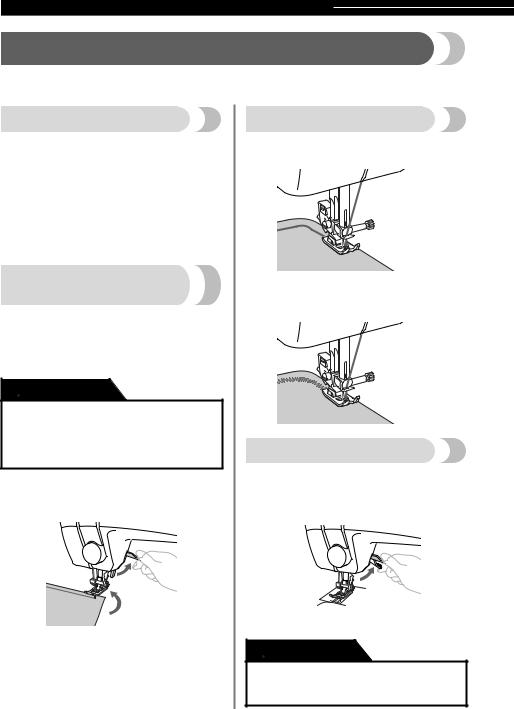
SEWING BASICS ———————————————————————————————————————————————————
USEFUL SEWING TIPS
Various ways to achieve better results for your sewing projects are described below. Refer to these tips when sewing your project.
Trial sewing
A trial piece of fabric should be sewn since, depending on the type of fabric and stitching being sewn, the desired results may not be achieved.
For the trial sewing, use a piece of fabric and thread that are the same as those used for your project, and check the thread tension and stitch length and width. Since the results differ depending on the type of stitching and the number of layers of fabric sewn, perform the trial sewing under the same conditions that will be used with your project.
Changing the sewing direction
aWhen the stitching reaches a corner, stop the sewing machine.
Leave the needle lowered (in the fabric). If the needle was raised, lower the needle by turning the handwheel toward you (counterclockwise).

 CAUTION
CAUTION
●When using the twin needle, be sure to raise the needle before changing the sewing direction. If the fabric is turned while the needle is lowered, the needle may bend or break.
bRaisefabric.the presser foot lever, and then turn the
Turn the fabric using the needle as a pivot.
cLowersewing.the presser foot lever and continue
Sewing curves
Stop sewing, and then slightly change the sewing direction to sew around the curve.
When sewing along a curve while using a zigzag stitch, select a shorter stitch length in order to obtain a finer stitch.
Sewing thick fabrics
■If the fabric does not fit under the presser foot
If the fabric does not fit easily under the presser foot, raise the presser foot lever even higher to bring the presser foot to its highest position.

 CAUTION
CAUTION
●If fabric more than 6 mm (15/64 inches) thick is sewn or if the fabric is pushed with too much force, the needle may bend or break.
25
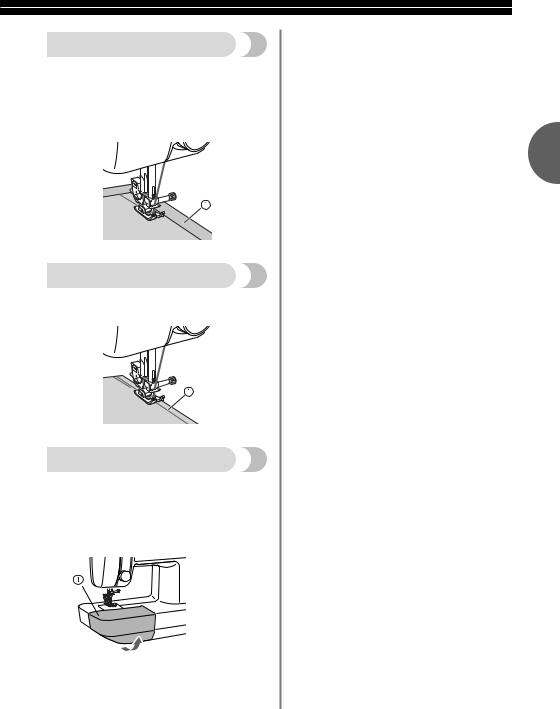
Sewing thin fabrics
When sewing thin fabrics, the stitching may become misaligned or the fabric may not feed correctly. If this occurs, place thin paper or stabilizer material under the fabric and sew it together with the fabric. When you have finished sewing, tear off any excess paper.
2
a Stabilizer material or paper
Sewing stretch fabrics
First, baste the pieces of fabric together, and then sew without stretching the fabric.
a Basting
Using a free-arm style
Free-arm sewing is convenient for sewing tubular and hard-to-reach areas.
To change your machine to the free-arm style, lift the bottom of the flat bed attachment toward you, and then pull the flat bed attachment out to remove it.
a Flat bed attachment
26
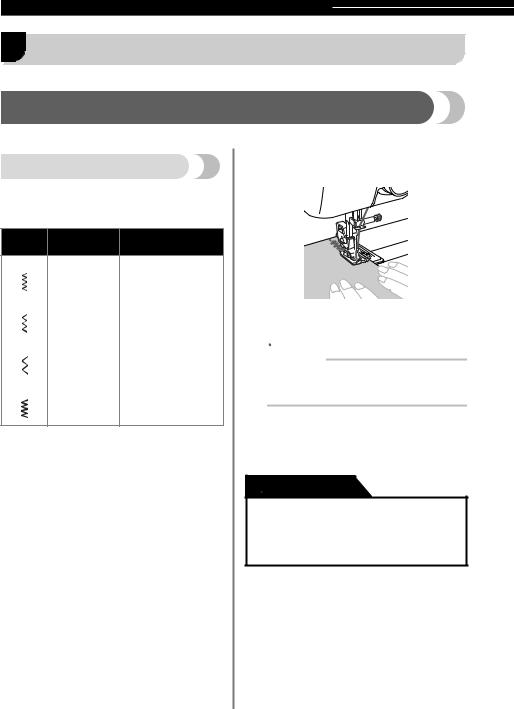
UTILITY STITCHES ——————————————————————————————————————————————————
3 UTILITY STITCHES
USEFUL STITCHES
Zigzag stitches
You can use the zigzag stitches to join together seams and finish them in one operation. They are also useful for sewing stretch materials.
Number
Stitch name Application
on dial
2 |
|
|
|
Zigzag stitch |
|
|
|
Overcasting and |
3 |
|
|
|
Zigzag stitch |
attaching appliqués. |
|
Select the desired |
|
|
|
|
|
|
width. |
4 |
|
|
|
Zigzag stitch |
|
|
|
|
5 |
Zigzag (satin) |
Overcasting and |
|
attaching appliqués |
|
|
stitch |
with the decorative |
|
|
satin stitches. |
|
|
|
aSelect a stitch.
•For details, refer to “Selecting stitching” (page 22).
bLower the needle into the fabric at the beginning of the stitching.
cStart sawing.
•For details, refer to “Starting to sew” (page 23).
 Memo
Memo
●When sewing with a zigzag stitch, use straight stitches at the beginning and end of the zigzag stitch for reinforcement.
dWhen sewing is finished, cut the thread.
•For details, refer to “Starting to sew” (page 23).

 CAUTION
CAUTION
●Slowly turn the handwheel toward you (counterclockwise) and check that the needle does not touch the presser foot. If the needle hits the presser foot, the needle may bend or break.
27
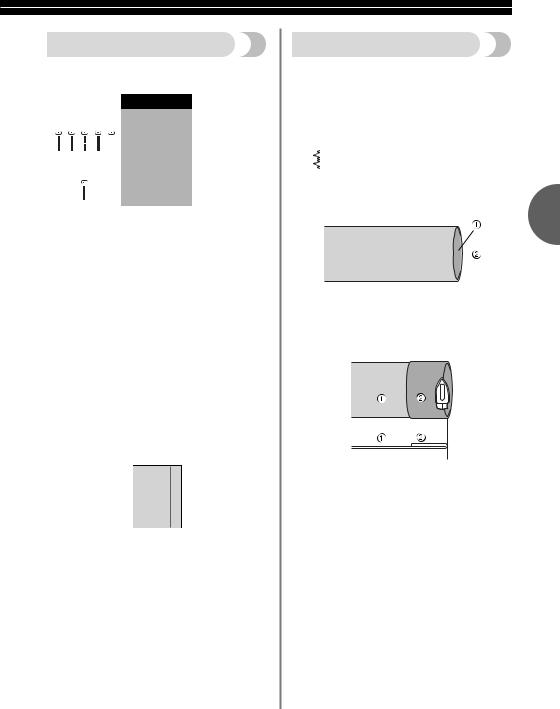
Basic stitching
Straight stitches are used for sewing plain seams. Two stitches are available for basic stitching.
Number on dial |
Stitch name |
Application |
|
|
|
Straight stitch |
Attaching |
6 7 8 9 10 |
zippers, basic |
||
|
|
(Center needle |
stitching, and |
|
|
position) |
sewing gathers |
|
|
|
or darning, etc. |
|
|
|
|
11 |
|
Straight stitch |
Basic stitching, |
|
|
||
|
|
(Left needle |
sewing gathers |
|
|
position) |
or pintucks, etc. |
|
|
|
|
aBaste or pin together the fabric pieces.
bSelect a stitch.
•For details, refer to “Selecting stitching” (page 22).
cLower the needle into the fabric at the beginning of the stitching.
dStart sewing.
•For details, refer to “Starting to sew” (page 23).
eWhen sewing is finished, cut the thread.
•For details, refer to “Starting to sew” (page 23).
Blind hem stitching
You can use the Blind Hem Stitch to finish the edge of a project, like the hem of a pair of trousers, without the stitch showing.
Number |
Stitch name |
Application |
|
on dial |
|||
|
|
||
12 |
Stretch blind |
Blind hem stitching on |
|
|
|||
|
Stitch |
stretch fabrics. |
|
|
|
|
aReverse the skirt or pants.
3
aRight side of fabric
bBottom side
bFold the fabric along the desired edge of the hem, and press.
<Seen from the side>
aWrong side of fabric
bRight side of fabric
28
